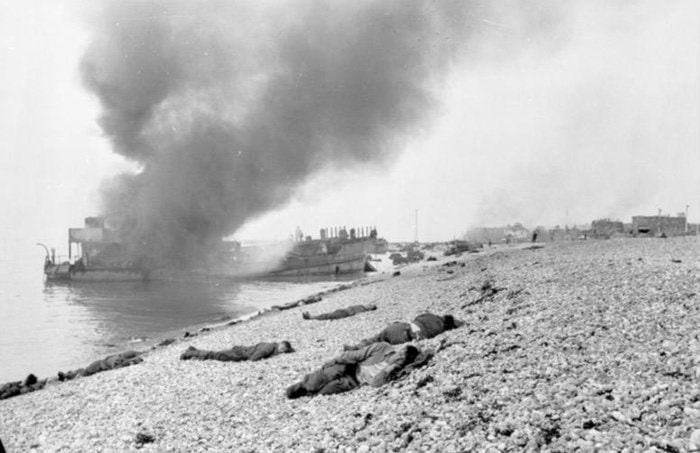Terrace resident Ken Anderson toured Canadian battlefields in Europe this past summer.
By Ken Anderson
Eighty-two-year-old Arnold Dudley and his older brother Jack came to Puys on the northern coast of France and received vastly different receptions.
They also came to Puys separated by seventy years. Arnold returned to Canada after his trip, his brother did not.
Arnold was part of a Canadian battlefield tour which was in Dieppe on Aug. 19, 2012 for the 70th anniversary and commemoration of Operation Jubilee, the raid by predominantly Canadian soldiers on the German held, and heavily fortified, port on Aug. 19, 1942.
Arnold’s brother, a sergeant in the Royal Canadian Artillery, took part in the raid and was mortally wounded on that disastrous day so long ago, a day in which 907 Canadian soldiers were killed and 1946 were captured.
Arnold fulfilled a promise he had made to himself by coming to Puys.
In the afternoon of this last Aug. 19, he went for a swim in the cold waters of the English Channel to honour his fallen brother, the same waters which bore his brother there but which never bore him home.
Earlier that day Arnold was among the many spectators taking in the official ceremony below an old castle off the beach at Dieppe.
Television crews covering the event noticed him standing behind a barrier holding high a photograph of his brother and came over and talked to him, learning the reason Arnold had come there that day.
Arnold did not come alone. His daughter-in-law and granddaughter accompanied him, and the other Canadians on the tour witnessed and supported him in his quest.
And there were hundreds, perhaps thousands, of Canadians there that day to pay tribute to and remember the fallen and to honour those who survived the battle and the war.
Seven veterans of the failed raid were present for the ceremonies, ninety-year-old soldiers, some in wheelchairs, some ambulatory with help from others, but standing erect in their berets and blue blazers, hands raised in salute as the bugler played.
Canadian flags were everywhere. Small plastic flags held by spectators in their hands or tucked into their hair. Flags flying on flagpoles. Huge maple leaf flags draped from balconies. Stylized maple leaf flags in the form of a dove, the symbol for the 70th anniversary commemorations. The emotions were almost overwhelming at times.
The French remember and are grateful for what Canada and her soldiers sacrificed for their country at Dieppe, throughout Normandy, in countless battles and at such cost to give them back their freedom and their country.
A contingent of Canadian soldiers marched to and from the Canadian Memorial Park to the stirring sound of drums and bagpipes.
A squad of French soldiers, submachine guns held across their chests, marched in quick step to join their Canadian counterparts.
A solitary Canadian piper played a lament as he stood below the looming backdrop of cliff and castle.
A lone Spitfire made two arching passes over the same castle, and two Belgian F-16s swept by.
But the most moving moment for me came as I stood near a cairn to the officers and men of the Royal Hamilton Light Infantry.
The Riley’s, as they are nicknamed, came ashore at Dieppe that day in 1942, and 197 of them were killed on the beach or as they tried to fight their way into the town.
As I stood talking to the officers of the regiment near that cairn, a young French woman came up to them and said that although she was too young to have had personal recollections of that day in 1942, she valued and was thankful for what their regiment and Canada had done for her country.
She then shook hands with each of the officers and, for whatever thoughts were going through her mind, shook mine also. I have to say, there were tears in my eyes and I could hardly speak.
And no sooner was this woman finished thanking the officers when two young Frenchmen came forward with young children in hand and also gave them thanks.
Sincere thanks, so simple and straightforward, graciously received and acknowledged by the officers on behalf of their regiment and their country.
Later that day as I walked through a tent camp set up on the Esplanade off the beach, looking at all of the military vehicles, equipment and weapons on display, I turned from what I had been viewing to go on to the next display.
Suddenly, from the corner of my eye, I caught a glimpse of someone so seemingly out of place amongst all the hardware of war that it stopped me in my tracks — a little girl sitting on a crate, bag of potato chips in one hand, her other hand raised to her head, an innocent, questioning look on her face.
She, to me, captured more than all of the equipment, the memorials, and the ceremonies themselves the essence of what all the suffering and sacrifice that Canadians and their allies was for — the right to live one’s life in freedom, to enjoy its simple pleasures, and to decide one’s own destiny.
